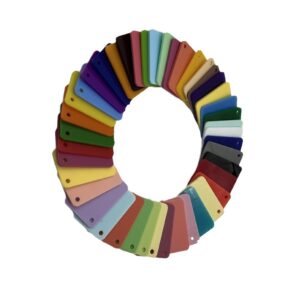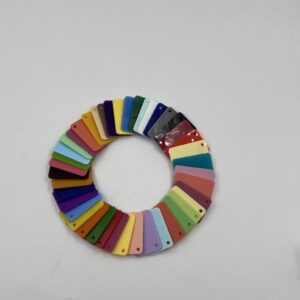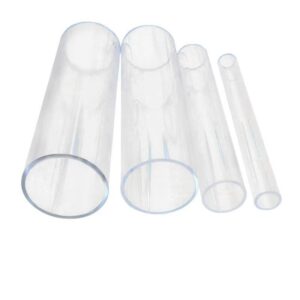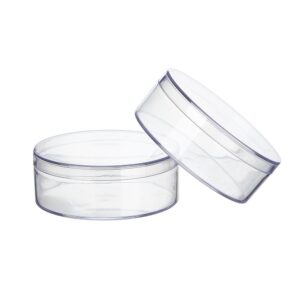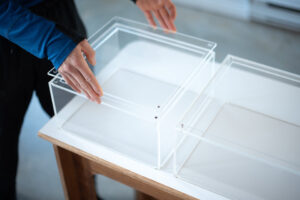Acrylic trays are simple tools that bring order and style to any space. You can find them in homes, offices, and stores. These clear containers are useful for many tasks. They hold items, display products, and serve food. Their clean look and strong build make them a popular choice for organization and decoration.
This guide explains everything about acrylic trays. We will cover the material they are made from. We will explore how people use them at home and at work. You will learn about creating custom trays for your specific needs. You will also get tips on how to care for them so they last a long time. This information will help you understand why so many people choose acrylic for their organizing and display needs.
Table of Contents
Understanding the Material What Is Acrylic
Acrylic is the common name for a type of plastic called Polymethyl Methacrylate, or PMMA. It is a transparent thermoplastic. People use it as a lightweight and shatter resistant alternative to glass. The material is known for its incredible clarity. Light passes through high grade acrylic almost perfectly, making it look like fine crystal. Its versatility makes it a key material in thousands of products, from windows to furniture.
A Brief History of Acrylic
The story of acrylic begins in the early 20th century. Chemists in Europe were experimenting with polymers. A polymer is a large molecule made of repeating smaller units. In 1933, a British company called Imperial Chemical Industries registered the material under the trade name Perspex. A few years later, an American company called Rohm and Haas introduced it as Plexiglas.
During World War II, the military used acrylic extensively. It was perfect for aircraft windows, canopies, and gun turrets. The material was strong, light, and much safer than glass if it broke. After the war, manufacturers looked for new ways to use this amazing material. They soon found that acrylic was perfect for consumer goods. Its clarity and ability to be molded into any shape made it ideal for home products, signs, and retail displays. The modern acrylic tray is a direct result of this long history of innovation.
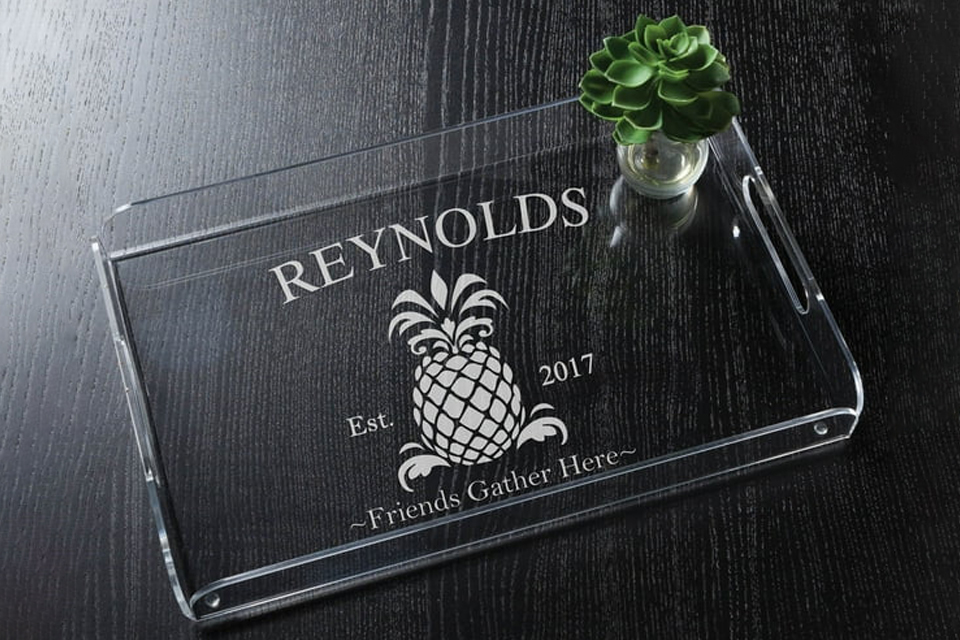
The Science Behind Acrylic PMMA
Polymethyl Methacrylate is a synthetic polymer. In simple terms, it is a strong and rigid plastic. Its chemical structure gives it unique properties. Acrylic is about half the weight of glass. This makes an acrylic tray much easier to carry than a glass one of the same size. Despite its low weight, it is very strong. Acrylic has a much higher impact strength than glass. It takes a lot more force to break it. When it does break, it usually fractures into large, dull edged pieces instead of shattering into tiny, sharp shards. This makes it a safer material for homes with children or pets.
The clarity of acrylic is one of its most important features. It allows more than 92% of visible light to pass through it. This is more than most types of glass. This property makes acrylic ideal for displays where you want the product to be the star. The material itself almost disappears. High quality acrylic also resists ultraviolet light, so it does not turn yellow when exposed to sunlight over time.
Is Acrylic an Eco Friendly Choice
The environmental impact of any plastic is an important topic. Acrylic, like other plastics, is derived from petroleum, a non renewable resource. Its production requires energy. However, the conversation about its environmental footprint is complex.
Acrylic is not a single use plastic. Products like acrylic trays are designed for long term use. Their durability means they do not need to be replaced often. A well made tray can last for decades. This longevity reduces waste compared to flimsy, disposable products. When an acrylic product does reach the end of its life, it can be recycled. Acrylic is a Type 7 plastic. Specialized recycling facilities can break it down. They can then reformulate the material into new acrylic sheets or other products. This process is called chemical recycling. It returns the plastic to its basic molecular state. This is more effective than just melting and remolding it.
Further, market trends for 2025 show a growing demand for sustainable materials in home goods. Manufacturers are responding by exploring bio based acrylics and improving recycling programs. Choosing a durable acrylic tray over a cheap, disposable alternative is a step toward less consumption and less waste. You can learn more about different plastic types and their recycling potential on various materials science websites.

The Manufacturing Process of Acrylic Trays
Creating an acrylic tray is a precise process. It turns a simple flat sheet into a functional and beautiful object. The process requires skill and specialized equipment. Manufacturers start with large sheets of high quality acrylic. From there, they use several techniques to shape, bend, and finish the tray. The quality of each step determines the quality of the final product.
From Sheet to Shape Fabrication Methods
The journey from sheet to tray involves a few key stages. Each one must be done with care to ensure the tray is strong, clear, and perfectly formed.
First, the acrylic sheet is cut to the right size. For simple rectangular trays, a table saw might be used. For more complex shapes or designs with cutout handles, a laser cutter is the best tool. A laser cutter uses a high powered beam of light to melt or vaporize the acrylic. This creates an incredibly precise and clean cut. The edge of a laser cut piece of acrylic is often smooth and polished right from the machine. This precision is essential for a professional look.
Next, the sides of the tray are formed. This is usually done through a technique called heat bending. A straight line on the flat acrylic piece is heated using a special tool called a strip heater. The heater warms the acrylic along a narrow line until it becomes soft and pliable. The operator then carefully bends the acrylic to the desired angle, usually 90 degrees. It is then held in a jig until it cools and becomes rigid again. This process is repeated for all four sides. It creates a seamless look without any joints at the corners.
The final step is bonding. If the tray design includes separate pieces, like dividers or attached handles, they are joined to the main body. This is done with a special solvent cement. The cement does not work like regular glue. Instead, it chemically melts the surfaces of the two acrylic pieces. When the solvent evaporates, the two pieces are fused into a single, solid piece of acrylic. A well made solvent joint is almost invisible and incredibly strong.
Customization Techniques
Beyond the basic shape, there are many ways to customize an acrylic tray. These techniques allow for unique designs that match a specific style or function. They turn a simple container into a personalized piece.
One popular method is engraving. Lasers can be used to etch intricate patterns, logos, or text onto the surface of the acrylic. The laser removes a very thin layer of the material. This creates a frosted look that contrasts with the clear, polished surface. Engraving is perfect for adding a personal touch or branding to a tray.
Printing is another option. With modern UV printing technology, full color images and graphics can be printed directly onto the acrylic. The ink is cured instantly by ultraviolet light. This creates a durable and vibrant finish. You can print a photo, a pattern, or a company logo on the bottom of a tray.
Color is also a key part of customization. While clear is the most common choice, acrylic is available in a huge range of colors. You can choose from solid, translucent, or even fluorescent colors. The material often comes in large colored acrylic sheets before being cut. Some trays even have special inserts. A suede or leather insert at the bottom of a tray adds a touch of luxury and protects delicate items.
Practical Applications for Acrylic Trays in Your Home
Acrylic trays are incredibly versatile. Their simple design and clear material allow them to fit into any room and with any decor style. They are not just for serving. They are powerful organizational tools that help reduce clutter and create a sense of calm. From the kitchen to the bedroom, an acrylic tray can bring order to your daily life. The principle of clear organization also applies to acrylic storage boxes, which help you see what you have at a glance.
Kitchen and Dining Uses
The kitchen is often the heart of the home. It is also a room that can easily become cluttered. Acrylic trays offer many solutions for kitchen organization and serving.
You can use a large acrylic tray for serving drinks and snacks when you have guests. It is lightweight, easy to carry, and simple to clean if something spills. A tray with handles is especially useful for this. You can also create a dedicated coffee or tea station. Place an acrylic tray next to your coffee maker. Use it to hold your sugar bowl, cream pitcher, and a container of coffee pods or tea bags. It keeps everything together and protects your counter from spills.
Inside your cabinets and pantry, acrylic trays can group similar items. Use one for all your baking spices. Use another for oils and vinegars. This way, you can just pull out the tray instead of searching for individual bottles. They are also great for the refrigerator. A tray can hold yogurts, condiments, or snacks. It makes it easy to see what you have and keeps shelves clean.
Living Room and Entryway Organization
In the living room, an acrylic tray can transform your coffee table. Use it to create a stylish and organized display. Place a few books, a small plant, and your remote controls on the tray. It corrals these items into one neat area. This makes the whole table feel less cluttered. Interior designer Eleanor Vance says, “Clutter is a visual distraction. An acrylic tray doesn’t add to the noise. It contains the chaos, creating a calm, designated spot for your things. It’s a simple tool for visual peace.”
If you have an ottoman instead of a coffee table, an acrylic tray is essential. It provides a hard, stable surface for you to place drinks or a snack plate. In your entryway, a small tray on a console table is the perfect catch all. It gives you a designated spot for your keys, wallet, and sunglasses. You will always know where to find them when you are ready to leave the house. A tray can also hold small decorative items. They offer a similar clear appeal to acrylic photo frames and can complement them well.
Bathroom and Vanity Solutions
Bathrooms and vanities are prime spots for clutter. Makeup, skincare products, and toiletries can quickly take over a countertop. Acrylic trays are an elegant solution.
Use a tray on your vanity to organize the products you use every day. Group your skincare bottles in one section and your makeup in another. The clear sides allow you to see everything at once. This makes your morning routine faster and more pleasant. Small acrylic trays are also perfect for inside drawers. They can separate makeup brushes, lipsticks, and eyeshadow palettes. Everything stays in its place.
On the bathroom counter, a tray can hold a soap dispenser, a toothbrush holder, and a cup. It protects the counter from water spots and soap residue. You can even use a small, sturdy tray in the shower. It can hold your shampoo, conditioner, and body wash, keeping them from toppling over.
Office and Workspace Clarity
A clear workspace can lead to a clear mind. Acrylic trays help you achieve this in your home office or at work. Use a tray on your desk to organize your essential supplies. It can hold pens, notepads, paper clips, and a stapler. Everything you need is within reach but contained in one spot.
Acrylic trays are also great as drawer organizers. You can find trays with built in dividers that are perfect for separating small office supplies like staples, rubber bands, and sticky notes. By organizing your desk and drawers, you create a more productive and less stressful work environment. For a complete and coordinated look, you can place small acrylic vases with a single flower on your organized desk.
Acrylic Trays in Professional and Commercial Settings
The benefits of acrylic trays extend far beyond the home. Their durability, clarity, and modern look make them ideal for a wide range of professional environments. Businesses in retail, hospitality, and healthcare use acrylic trays to improve displays, streamline service, and maintain organization. They present a professional image while serving a practical purpose.
Elevating Retail Displays
In retail, presentation is everything. How a product is displayed has a direct impact on sales. Acrylic trays are a favorite tool for visual merchandisers because they put the focus squarely on the product.
Jewelry stores use shallow acrylic trays with fabric inserts to showcase necklaces, rings, and bracelets. The clear sides of the tray do not distract the eye, making the jewelry pop. Cosmetic counters use trays to organize rows of lipsticks, foundations, and eyeshadows. This creates a clean, uniform look that is appealing to customers. A 2024 report from the Retail Design Institute notes that stores using clear, minimalist displays saw up to a 15% increase in customer engagement with featured products.
Boutiques and high end stores use acrylic trays to display small leather goods, sunglasses, or tech accessories. Bakeries and cafes use them as well. A large acrylic tray is a perfect way to present croissants, muffins, and other pastries on the counter. The tray protects the food and makes it look irresistible. Because acrylic is easy to clean, it is a hygienic choice for food display.
Hospitality and Food Service
The hospitality industry relies on efficiency and presentation. Acrylic trays help on both fronts. Hotels use them for room service delivery. They are lighter than traditional metal or wood trays, making them easier for staff to carry. They are also durable and easy to sanitize between uses. In hotel lobbies, acrylic trays can be used on coffee tables to hold magazines or on reception desks to organize pens and registration forms.
Restaurants and bars use acrylic trays in many ways. A bartender might use a small tray to carry drinks to a table. Trays can also be used to organize condiment stations, holding salt and pepper shakers, sugar packets, and sauce bottles. This keeps tables and service areas tidy. Caterers also love acrylic trays. They are perfect for serving appetizers and desserts at events. Their sleek, modern look fits with any party theme.
Specialized Professional Uses
Many other industries have found uses for acrylic trays. In medical and dental offices, they are used to organize and transport small instruments and supplies. Their non porous surface is easy to sterilize. Dentists use custom acrylic trays to take impressions of a patient’s teeth. Spas and salons use them to present hot towels, manicure tools, or product samples to clients. It adds a touch of luxury to the experience.
Even museums and galleries use acrylic. A small, archival quality acrylic tray can be used to display delicate artifacts or specimens without distracting from the item itself. The material’s UV resistance helps protect sensitive objects from light damage. This shows the incredible range of applications for such a simple product.
Customization Creating a Tray Just for You
While standard acrylic trays are useful, sometimes you need something specific. You might need a tray that fits perfectly into a particular drawer. You might want a color that matches your brand. You might need a unique design for a special purpose. This is when you should choose custom acrylic trays to fit your exact needs. Customization allows you to get a product that is perfectly tailored to your vision and requirements.
Why Choose a Custom Tray
There are many reasons to opt for a custom acrylic tray. The most common reason is size. Standard trays might be too big or too small for your space. With a custom order, you can specify the exact length, width, and height. This ensures a perfect fit for your countertop, drawer, or display case.
Style is another key reason. A custom tray lets you express your personal or brand identity. You can choose a unique shape, a specific color, or a special finish like frosted or mirrored acrylic. You can add features that are not available on standard trays, like custom dividers or unique handle styles. A custom tray becomes more than just an organizer. It becomes a piece of decor.
Function is also critical. You may have a specific use in mind that no standard tray can fulfill. For example, you might need a tray with special compartments to hold specific tools or products. A custom tray can be designed from the ground up to solve your unique organizational problem.
Popular Customization Options
When you order a custom acrylic tray, you have many options to choose from. These options allow you to control every aspect of the final product.
- Size and Shape: The most basic customization is size. You can dictate the exact dimensions you need. You can also move beyond a simple rectangle. You can order a square, round, oval, or even an L shaped tray to fit a corner.
- Color and Finish: Clear is classic, but it is not your only option. You can choose from dozens of solid and translucent colors to match any color scheme. Frosted acrylic provides a soft, diffused look. Mirrored acrylic adds a touch of glamour. You can even get colored acrylic sheets with special patterns.
- Handles and Feet: Handles make a tray easier to carry. You can choose cutout handles, which are sleek and modern. Or you can opt for attached handles made from acrylic, metal, or leather. You can also add small, clear rubber feet to the bottom of the tray. These feet prevent the tray from sliding and protect both the tray and the surface it sits on from scratches.
- Engraving and Personalization: Adding a personal touch is easy with laser engraving. You can have your initials, a name, a favorite quote, or a company logo etched onto the tray. This is a popular option for gifts and branded corporate items.
- –Dividers and Inserts: For maximum organization, you can add dividers to your tray. These can be fixed or removable. They create separate compartments for different items. You can also add a custom insert made from a different material, like felt, suede, or leather. This adds a soft touch and is great for protecting delicate items like jewelry or glasses.
Care and Maintenance for Long Lasting Clarity
Acrylic trays are durable and designed to last. With proper care, your tray can maintain its crystal clarity and beautiful finish for many years. Following a few simple rules for cleaning and handling will prevent damage and keep your tray looking new. As materials expert Dr. Kenji Tanaka notes, “The true strength of modern acrylic is its stability and clarity. Unlike older plastics, high quality PMMA resists yellowing and maintains its structural integrity for years, making it a reliable material for both consumer and industrial products.”
The Right Way to Clean Acrylic
Cleaning acrylic is easy, but it is important to use the right materials. The wrong cleaners or cloths can scratch the surface and create a cloudy appearance.
For routine cleaning, all you need is a soft cloth and some mild soap and water. A microfiber cloth is the best choice because it is soft and lint free. Wet the cloth with a solution of warm water and a few drops of dish soap. Gently wipe the surface of the tray. Then, rinse the tray with clean water or wipe it down with a separate damp cloth to remove any soap residue. Finally, blot the tray dry with another clean, soft cloth. Do not rub it dry, as this can create static electricity which attracts dust.
There are a few things you must avoid. Never use cleaners that contain ammonia, like many common glass cleaners. Ammonia can cause the acrylic to become cloudy and develop tiny cracks over time. This is called crazing. Also, avoid abrasive cleaners and rough materials like paper towels or scrubbing sponges. These will leave fine scratches on the surface, dulling its shine. Stick to mild soap and soft cloths.
Removing Scratches and Restoring Shine
Even with careful handling, minor scratches can sometimes appear on an acrylic surface. The good news is that you can often polish out light scuffs and scratches.
For very fine surface scratches, you can use a special plastic polish. You can find these polishes online or at hardware stores. Apply a small amount of the polish to a clean microfiber cloth. Rub the scratched area in a circular motion, using gentle but firm pressure. Continue rubbing for a few minutes. Then, use a clean part of the cloth to buff the area until it shines. This can make a big difference and restore the tray’s clarity.
For deeper scratches, you may need a multi step scratch removal kit. These kits usually come with several grades of sandpaper and a polishing compound. This process requires more care and should be tested on an inconspicuous area first. For very deep gouges, it may be difficult to restore a perfect finish at home.
Proper Handling and Storage
Preventing damage is always easier than repairing it. Handle your acrylic tray with care to avoid drops and impacts. While acrylic is strong, a hard fall onto a concrete floor can still cause it to crack or break.
When storing your tray, try to keep it in a place where it will not get bumped or scratched by other objects. If you need to stack multiple trays, place a soft cloth between each one to protect their surfaces.
Finally, while high quality acrylic has UV resistance, it is still a good idea to avoid long term, direct exposure to intense sunlight. Over many years, extreme sun exposure could potentially cause some materials to become brittle. For everyday indoor use, this is not a concern.
Acrylic Trays vs. Other Materials
When choosing a tray, you have many material options. Glass, wood, and metal are all common choices. Each material has its own strengths and weaknesses. Understanding how acrylic compares to these other options can help you decide which material is right for your needs. Acrylic often provides a unique combination of clarity, durability, and modern style that other materials cannot match.
Acrylic vs. Glass
Glass is the most traditional material for clear trays and decorative items. It offers excellent clarity and has a classic, high end feel. However, it has some significant drawbacks compared to acrylic.
The biggest difference is weight and durability. Glass is much heavier than acrylic. A large glass tray can be heavy and difficult to carry. Glass is also very fragile. It can shatter from a small impact, creating a dangerous mess of sharp pieces. Acrylic, on the other hand, is lightweight and much more shatter resistant. This makes it a safer and more practical choice, especially in homes with children or in busy commercial settings. The American Society of Interior Designers (ASID) often recommends shatter resistant materials for high traffic family homes.
In terms of clarity, high quality acrylic is actually clearer than standard glass. Standard glass has a slight green tint, which you can see when you look at it from the edge. Acrylic is almost perfectly clear. While specialized low iron glass can match this clarity, it is much more expensive.
Acrylic vs. Wood
Wood trays offer a warm, natural, and traditional look. They are available in many different types of wood and finishes, from rustic pine to elegant walnut. Wood is a strong and durable material. A well made wooden tray can last a lifetime.
However, wood is not a good choice for every situation. It is not transparent, so it cannot provide the clear, minimalist look of an acrylic tray. Wood is also susceptible to water damage. If you spill a drink on a wooden tray and do not clean it up quickly, the wood can warp, stain, or crack. It requires more maintenance, such as occasional oiling, to keep it in good condition.
Acrylic trays are completely waterproof. Spills are no problem. You can just wipe them up. They do not stain easily and require no special maintenance beyond simple cleaning. For use in kitchens, bathrooms, or for serving drinks, acrylic is often a more practical choice than wood.
Acrylic vs. Metal
Metal trays, made from materials like stainless steel, aluminum, or brass, offer a sleek, industrial, or glamorous look. They are extremely durable and will not break if dropped. They are a popular choice in modern and contemporary design.
Like wood, metal trays are opaque. They cannot provide the see through quality of acrylic. Weight can also be a factor. A large stainless steel tray can be quite heavy. Some metals also require special care. Brass and silver trays can tarnish over time and need regular polishing to maintain their shine. Stainless steel can show fingerprints and water spots easily.
Acrylic trays offer a different kind of modern aesthetic. They feel lighter and more open. They are also corrosion proof. You never have to worry about an acrylic tray rusting or tarnishing. They provide a clean, modern look without the maintenance or weight of many metal alternatives.
Conclusion
Acrylic trays are more than just simple plastic containers. They are well designed tools that blend function and style. Their strength, clarity, and light weight make them a superior choice for many uses. From organizing a busy kitchen counter to creating an elegant retail display, these trays provide a practical and beautiful solution.
You can use them to serve guests, to organize your desk, or to keep your bathroom vanity tidy. The ability to create custom trays means you can get the exact size, shape, and style you need for any project. They are easy to clean and care for, ensuring they will look great for years. When you compare acrylic to other materials like glass, wood, or metal, it offers a unique set of benefits that are hard to beat. For a modern, durable, and endlessly versatile organizational tool, an acrylic tray is an excellent choice.
Frequently Asked Questions
Are acrylic trays durable? Yes, acrylic is a very durable material. It has high impact resistance, meaning it is much less likely to break than glass if dropped. It is also resistant to chipping and cracking with normal use.
Can you put hot things on an acrylic tray? You should be careful with hot items. Acrylic can soften or warp at high temperatures, typically above 160 degrees Fahrenheit or 70 degrees Celsius. It is safe for serving warm food or a cup of coffee, but you should not place a hot pan directly from the stove onto an acrylic tray. Use a trivet for very hot dishes.
Does acrylic turn yellow over time? High quality, modern acrylic is made with UV stabilizers. This prevents it from turning yellow when exposed to normal indoor lighting or indirect sunlight. Very old or low quality acrylic might show some yellowing after many years of direct sun exposure, but this is not a concern for most modern, well made products.
How do you get scratches out of acrylic? You can remove fine surface scratches from acrylic. Use a special plastic polishing compound and a soft microfiber cloth. Apply the polish and rub the scratched area gently in a circular motion. This will buff out the scratches and restore the shine.
Is acrylic better than plastic for trays? Acrylic is a type of plastic, but it is generally considered a higher grade material than other common plastics like polystyrene or polypropylene. Acrylic is prized for its superior clarity, scratch resistance, and rigid, sturdy feel. It looks more like glass and has a more premium appearance than most other plastics.
Are acrylic trays food safe? Yes, acrylic is generally considered food safe. The material is non toxic and does not leach chemicals. It is a non porous surface, which means it is easy to clean and does not harbor bacteria. Many restaurants and cafes use acrylic trays for serving and displaying food.





